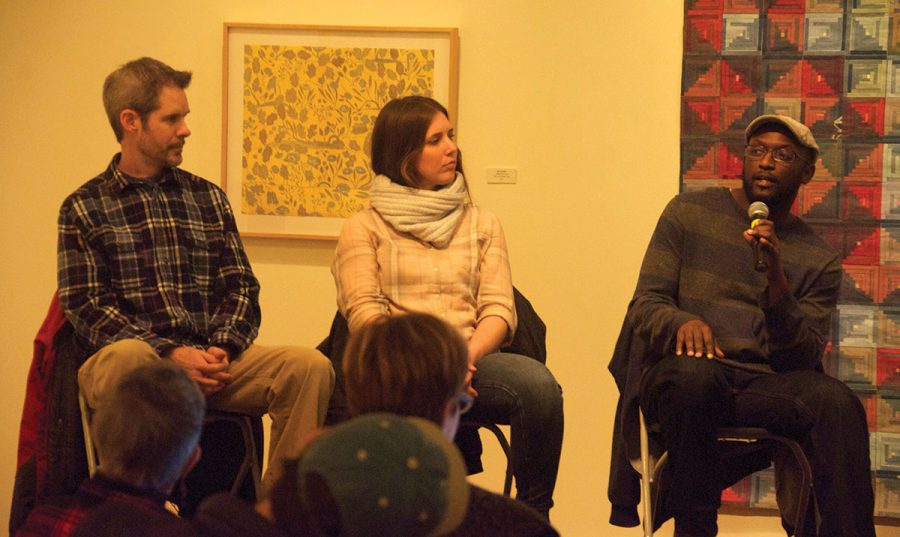Guilford’s art faculty talks building a career in the field, their own work and struggles
From creating a body of work to the importance of social networks, Guilford College’s art faculty discussed the various aspects of a successful art career with the community. The discussion took place in the Hege Library Art Gallery on Wednesday, Jan. 31.
With the current showing of the Guilford College Art Faculty Biennial Exhibition, the speakers could provide insights on careers in art while surrounded by their own work in the gallery.
The discussion panel included Part-time Lecturer for Art Meg Stein, Professor of Art Roy Nydorf, Assistant Professor of Art Mark Dixon, Visiting Instructor of Art/Experiential Learning Maia Dery, who joined the discussion through Skype, Assistant Professor for Art Antoine Williams, Visiting Lecturer for Art Katy Collier and Visiting Half-time Instructor of Art Charlie Tefft.
Despite their experience and accomplishments, the speakers did not hesitate to acknowledge the difficulty of pursuing art.
“As an artist, you make a lot of sacrifices,” said Collier. “… You also have to decide, what are the sacrifices you are willing to make and the things that are truly important to you and what you want to prioritize. … It’s about truly following the thing that you love to do.”
With an audience composed primarily of art thesis students, the art faculty also addressed the challenges of finding work. Collier suggested for students to explore as many avenues as possible to gain professional experience, despite how strenuous the application process can be.
“Apply so much and don’t take it personally,” said Collier. “You should be applying to 20 things a month and expect to maybe get one if you’re lucky, and you shouldn’t be offended by that at all.
“So you just have to be really honest with yourself about what is important to you and just apply so much.”
Williams emphasized the importance of developing social connections.
“Also, I think something that’s really important is social capital,” said Williams. “You’ll need a network. The one that you have now, because you’re thesis students, you all know each other, … you can each be resources for one another. But in your particular field, find other people who are doing what you’re doing and befriend them … because it can get really isolated in front of a computer or in a painting studio … you need other people because it can get pretty lonely.”
Because pursuing a career in art is not usually a linear path after graduation, Williams encouraged students to ask questions about their future in order to determine what their next steps would be.
“After I get the diploma, the degree, will I need to work the next day? And if you do, you should try to make plans now. Like what is your life going to look like?” said Williams. “Those are questions you really need to ask yourself.”
Throughout the panel, art thesis students posed questions to the speakers. Senior Elena Sippel asked about the process of writing proposals and artist statements, a process that thesis students are asked to participate in for art classes as well.
“Definitely, I am constantly writing proposals and constantly re-working my artist statement,” said Stein. “Both of those things are super important for most things that you apply for, most grants or residencies and shows, too.
“Your artist statement in particular … it takes a lot of work and a lot of revising to try to figure out what you’re actually saying.”
At its heart, the panel focused on the fluidity and creativity that art allows for those who chose to pursue it.
“I think the only thing that really seems to be constant is you have to work,” said Williams. “If you’re not working, you can’t make a cohesive body of work, … but different artists have different ways of approaching that.”








